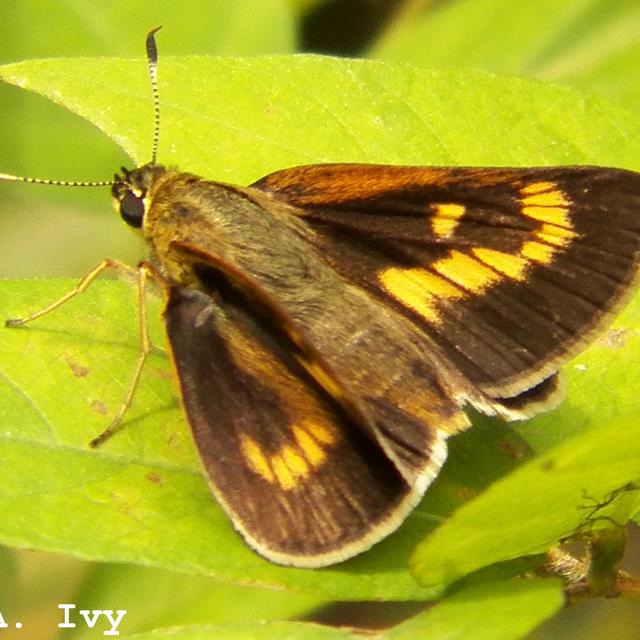Byssus Skipper
Problema byssus (W.H. Edwards, 1880)
Family: Hesperiidae
Subfamily: Hesperiinae
Identification: Upperside is bright yellow-orange with black borders and a black bar at the end of the cell. Females are much darker than males. Underside of hindwing is dull yellow in males and rust or orange in females; both with a band of pale spots.
Wing Span: 1 7/16 - 1 13/16 inches (3.7 - 4.6 cm).
Life History: Females lay eggs singly on host plant leaves. Caterpillars live in shelters of rolled or tied leaves, feed on leaves, and overwinter in their fourth stage of development. After completing their growth in the spring, the caterpillars pupate in dense silk cocoons in litter at the base of the host plant.
Flight: One brood from June-July in the Midwest; two broods from April-October along the Atlantic Coast.
Caterpillar Hosts: Eastern grama grass (Tripsacum dactyloides).
Adult Food: Nectar from flowers including pickerelweed.
Habitat: Tall-grass prairie in the Midwest, edges of coastal marshes along the Atlantic Coast.
Range: Along the Atlantic coastal plain from North Carolina south to Florida and the Gulf States; and in the Midwest from northern Indiana west to Iowa and south to Missouri and Kansas.
Conservation: Populations should be conserved wherever found.
NCGR: G3 - Very rare or local throughout its range or found locally in a restricted range (21 to 100 occurrences). (Threatened throughout its range).
Management Needs: Extirpation of local populations should be avoided by avoiding or limiting the use of fire as a management tool.
Comments: NULL
Please donate!
We depend on donations to keep Butterflies and Moths of North America freely available. We want to express our gratitude to all who showed their support by making a contribution this year. You can donate to support this project at any time.
Advertise with us!
Do you have a product or service that you think would interest BAMONA users? If you would like to advertise on this website, contact us by email, or use the contact form and select the "Advertising" category.
Verified Sightings
Displaying 1 - 24 of 345 verified sightings

Observation date: May 26, 2025
Submitted by: ncrosbyrd
Region: Liberty County, Georgia, United States
Verified by: Mikelchap
Verified date: Jul 20, 2025

Observation date: May 26, 2025
Submitted by: ncrosbyrd
Region: McIntosh County, Georgia, United States
Verified by: Mikelchap
Verified date: Jul 20, 2025

Observation date: Apr 15, 2025
Submitted by: hockeybruce7
Region: Orange County, Florida, United States
Verified by: John Calhoun
Verified date: Apr 27, 2025

Observation date: May 26, 2023
Submitted by: dvollmar
Region: Wakulla County, Florida, United States
Verified by: John Calhoun
Verified date: Aug 14, 2024

Observation date: Jun 22, 2024
Submitted by: gunhilda
Region: Payne County, Oklahoma, United States
Verified by: CA Ivy
Verified date: Jun 24, 2024

Observation date: May 20, 2024
Submitted by: Dennis Forsythe
Region: Charleston County, South Carolina, United States
Verified by: Dennis Forsythe
Verified date: May 21, 2024

Observation date: Aug 26, 2023
Submitted by: Dennis Forsythe
Region: Jasper County, South Carolina, United States
Verified by: Dennis Forsythe
Verified date: Aug 27, 2023

Observation date: Jun 25, 2023
Submitted by: Ozark_Bill
Region: St. Louis County, Missouri, United States
Verified by: CA Ivy
Verified date: Aug 24, 2023

Observation date: Jul 05, 2023
Submitted by: cklindsey
Region: Cherokee County, Oklahoma, United States
Verified by: CA Ivy
Verified date: Jul 19, 2023

Observation date: Jul 01, 2023
Submitted by: naj.pilla
Region: Callaway County, Missouri, United States
Verified by: CA Ivy
Verified date: Jul 04, 2023

Observation date: Aug 12, 2007
Submitted by: Russ Wigh
Region: Chatham County, Georgia, United States
Verified by: Mikelchap
Verified date: May 27, 2023

Observation date: Aug 28, 2007
Submitted by: Russ Wigh
Region: Chatham County, Georgia, United States
Verified by: Mikelchap
Verified date: May 27, 2023

Observation date: Sep 07, 2022
Submitted by: Eric Wood
Region: Boone County, Missouri, United States
Verified by: Eric Wood
Verified date: Sep 09, 2022

Observation date: Aug 22, 2022
Submitted by: sgensits
Region: Leon County, Florida, United States
Verified by: John Calhoun
Verified date: Aug 22, 2022

Observation date: Aug 10, 2022
Submitted by: rpanetta
Region: Gwinnett County, Georgia, United States
Verified by: Mikelchap
Verified date: Aug 13, 2022

Observation date: Jun 05, 2022
Submitted by: ncrosbyrd
Region: Berkeley County, South Carolina, United States
Verified by: Dennis Forsythe
Verified date: Jun 08, 2022

Observation date: Sep 02, 2021
Submitted by: AJ Trently
Region: Decatur County, Tennessee, United States
Verified by: James Steen
Verified date: Jun 01, 2022

Observation date: Jun 19, 2021
Submitted by: Alexis Powell
Region: Chase County, Kansas, United States
Verified by: James Steen
Verified date: May 30, 2022

Observation date: Jul 04, 2021
Submitted by: EastKansas
Region: Douglas County, Kansas, United States
Verified by: azukoff
Verified date: Apr 06, 2022

Observation date: Aug 30, 2018
Submitted by: Mark Salvato
Region: Craven County, North Carolina, United States
Verified by: Dennis Forsythe
Verified date: Nov 26, 2021

Observation date: May 26, 2017
Submitted by: Mark Salvato
Region: Gadsden County, Florida, United States
Verified by: John Calhoun
Verified date: Nov 21, 2021

Observation date: Sep 26, 2021
Submitted by: Mark Salvato
Region: Sumter County, Florida, United States
Verified by: John Calhoun
Verified date: Oct 07, 2021

Observation date: Sep 02, 2019
Submitted by: Mark Salvato
Region: Leon County, Florida, United States
Verified by: John Calhoun
Verified date: Sep 29, 2021

Observation date: Aug 29, 2020
Submitted by: Mark Salvato
Region: Orange County, Florida, United States
Verified by: John Calhoun
Verified date: Sep 07, 2021
- 1 of 15
- next ›










